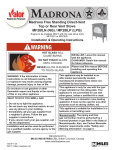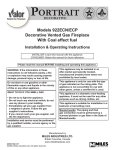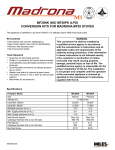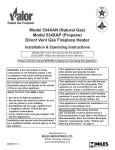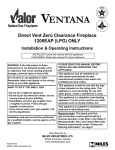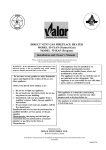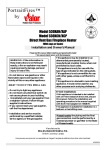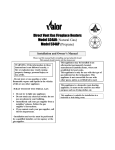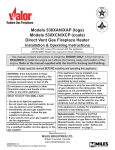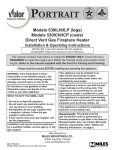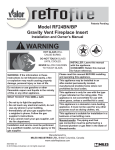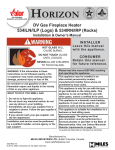Download Miles Industries MF28EN Operating instructions
Transcript
Madrona Free Standing Direct-Vent Top or Rear Vent Stove MF28EN (NG) / MF28EP (LPG) Engine to be installed ONLY with the cast stove body MFCS01 or MFCS02 Installation & Operating Instructions INSTALLER: Leave this manual with the appliance. CONSUMER: Retain this manual for future reference. WARNING: If the information in these instructions is not followed exactly, a fire or explosion may result causing property damage, personal injury or loss of life. Do not store or use gasoline or other flammable vapors and liquids in the vicinity of this or any other appliance. WHAT TO DO IF YOU SMELL GAS • Do not try to light the appliance. • Do not touch any electrical switch; do not use any phone in your building. • Immediately call your gas supplier from a neighbor’s phone. Follow the gas supplier’s instructions. • If you cannot reach your gas supplier, call the fire department. Installation and service must be performed by a qualified installer, service agency or the gas supplier. PLEASE READ THIS MANUAL BEFORE INSTALLING AND OPERATING THIS APPLIANCE. This appliance may be installed in an after-market permanently located, manufactured (mobile) home where not prohibited by local codes. This appliance is only for use with the type of gas indicated on the rating plate. This appliance is not convertible for use with other gases, unless a certified kit is used. This appliance is a domestic room-heating appliance. It must not be used for any other purposes such as drying clothes, etc. This appliance is suitable for installation in a bedroom or bed sitting room. Massachusetts: The piping and final gas connection must be performed by a licensed plumber or gas fitter in the State of Massachusetts. Also, see Carbon Monoxide Detector requirements under “Safety and Warning Information” on page 5. Manufactured by MILES INDUSTRIES LTD. 4000973/07 ©2006, Miles Industries Ltd. British Columbia, Canada www.milesfireplaces.com Thank You ... For purchasing the Madrona by Miles Industries. Your new radiant gas heater is a technical appliance that must be installed by a qualified dealer. Each Madrona is fully tested during the production process for your safety and comfort. Your unit has been professionally installed by: Dealer Name _______________________________________ Phone Number ______________________________________ Should you encounter an operational problem, call your dealer immediately. Do not try to repair the unit as you may cause an injury or damage the fireplace. Table of Contents Safety & Warning Information......................................................4 Specifications................................................................................7 Approval & Codes — Ratings — High Altitude Installations— Supply Gas — Electrical Dimensions & Clearances............................................................8 Dimensions — Hearth Requirements — Clearances CONTENTS Venting..........................................................................................10 Top / Rear Outlet — Vent Material — Wall Thickness — Framing Vent in Combustible Walls & Ceilings — Typical Venting Components — How to Read the Venting Chart — Venting Chart — Restrictors — Vent Termination Installation................................................................................... 15 Fan (Blower) — Venting Configuration — Gas Line Routing Packs Contents—Appliance & Castings.................................. 15 Appliance Preparation................................................................16 Window & Log Pack — Cast Base — Engine —Cast Side Panels — Fixing Casting Side Panels & Engine — Lighting Instructions Plate — Remote Control Receiver — Gas Pipe & Connector — Receiver Position — Optional Fan (Blower) — Venting Outlet — Top Spar — Front Hooks — Rear Log Support Supply Gas.................................................................................. 21 Ceramic Logs.............................................................................. 22 Window Refitting.........................................................................23 Operation Check & Aeration Settings Adjustment.................. 23 Aeration Settings — Air Shutter Front & Top Installation.............................................................. 24 Remote Control Handset Wall Holder........................................25 Owner’s Information................................................................... 26 Operating Your Stove — Cleaning — Checks — Batteries — Touch-up Paint — Servicing — Remote Control Operation — Manual ON/OFF Switch Lighting Instructions.................................................................. 31 Wiring Diagram........................................................................... 32 Options........................................................................................ 33 Venting accessories................................................................... 34 Warranty...................................................................................... 37 Replacement Parts..................................................................... 38 SAFETY INFORMATION Safety & Warning Information READ and UNDERSTAND all instructions carefully before starting the installation. FAILURE TO FOLLOW these installation instructions may result in possible fire hazard and will void the warranty. Prior to the first firing of the fireplace, READ the Owner’s Information section of this manual. DO NOT USE this appliance if any part has been under water. Immediately, CALL a qualified service technician to inspect the unit and to replace any part of the control system and any gas control that has been under water. THIS UNIT IS NOT FOR USE WITH SOLID FUEL. Installation and repair should be PERFORMED by a qualified service person. The appliance and venting system should be INSPECTED before initial use and at least annually by a professional service person. More frequent cleaning may be required due to excessive lint from carpeting, bedding, etc. It is IMPERATIVE that the unit’s control compartment, burner, and circulating air passageways BE KEPT CLEAN to provide for adequate combustion and ventilation air. Always KEEP the appliance clear and free from combustible materials, gasoline, and other flammable vapors and liquids. NEVER OBSTRUCT the flow of combustion and ventilation air. Keep the front of the appliance CLEAR of all obstacles and materials for servicing and proper operation. Due to the high temperature, the appliance should be LOCATED out of traffic areas and away from furniture and draperies. Clothing or flammable material SHOULD NOT BE PLACED on or near the appliance. Children and adults should be ALERTED to the hazards of high surface temperature and should STAY AWAY to avoid burns or clothing ignition. Young children should be CAREFULLY SUPERVISED when they are in the same room as the appliance. This gas fireplace and vent assembly MUST be vented directly to the outside and MUST NEVER be attached to a chimney serving a separate solid fuel burning appliance. Each gas appliance MUST USE a separate vent system. Common vent systems are PROHIBITED. INSPECT the external vent cap on a regular basis to make sure that no debris, plants, trees, shrubs are interfering with the air flow. The glass door assembly MUST be in place and sealed before the unit can be placed into safe operation. DO NOT OPERATE this appliance with the glass door removed, cracked, or broken. Replacement of the glass door should be performed by a licensed or qualified service person. DO NOT strike or slam the glass door. The glass door assembly SHALL ONLY be replaced as a complete unit, as supplied by the fireplace manufacturer. NO SUBSTITUTE material may be used. DO NOT USE abrasive cleaners on the glass door assembly. DO NOT ATTEMPT to clean the glass door when it is hot. Turn off the gas before servicing this appliance. It is recommended that a qualified service technician perform an appliance check-up at the beginning of each heating season. Any safety screen or guard removed for servicing must be replaced before operating this appliance. DO NOT place furniture or any other combustible household objects within 36” of the fireplace front. BE CAREFUL not to put any decorating objects sensitive to heat on the stove or too close to the stove as it gets very hot when operating. DO NOT use this heater as a temporary source of heat during construction. This unit MUST be used with a vent system as described in this installation manual. NO OTHER vent system or components MAY BE USED. NOTE: When operating your new fireplace for the first time, some vapors may be released due to the burning of curing compounds used in the manufacture of the appliance. They may cause a slight odor and could cause the flames to be the full height of the firebox, or even slightly higher, for the first few hours of operation. It is also possible that these vapors could set off any smoke detection alarms in the immediate vicinity. These vapors are quite normal on new appliances. We recommend opening a window to vent the room. After a few hours’ use, the vapors will have disappeared and the flames will be at their normal height. Safety & Warning Information Massachusetts State of California. Proposition 65 Warning. Fuels used in gas, wood-burning or oil fired appliances, and the products of combustion of such fuels, contain chemicals known to the State of California to cause cancer, birth defects and other reproductive harm. California Health & Safety Code Sec. 25249.6. State of Massachusetts Carbon Monoxide Detector/Vent Terminal Signage Requirements SAFETY INFORMATION California For all side wall horizontally vented gas fueled equipment installed in every dwelling, building or structure used in whole or in part for residential purposes, including those owned or operated by the Commonwealth and where the side wall exhaust vent termination is less than seven (7) feet above finished grade in the area of the venting, including but not limited to decks and porches, the following requirements shall be satisfied: 1. INSTALLATION OF CARBON MONOXIDE DETECTORS. At the time of installation of the side wall horizontal vented gas fueled equipment, the installing plumber or gasfitter shall observe that a hard wired carbon monoxide detector with an alarm and battery backup is installed on the floor level where the gas equipment is to be installed. In addition, the installing plumber or gasfitter shall observe that a battery operated or hard wired carbon monoxide detector with an alarm is installed on each additional level of the dwelling, building or structure served by the side wall horizontal vented gas fueled equipment. It shall be the responsibility of the property owner to secure the services of qualified licensed professionals for the installation of hard wired carbon monoxide detectors. a. In the event that the side wall horizontally vented gas fueled equipment is installed in a crawl space or an attic, the hard wired carbon monoxide detector with alarm and battery back-up may be installed on the next adjacent floor level. b. In the event that the requirements of this subdivision can not be met at the time of completion of installation, the owner shall have a period of thirty (30) days to comply with the above requirements; provided, however, that during said thirty (30) day period, a battery operated carbon monoxide detector with an alarm shall be installed. 2. APPROVED CARBON MONOXIDE DETECTORS. Each carbon monoxide detector as required in accordance with the above provisions shall comply with NFPA 720 and be ANSI/ UL 2034 listed and IAS certified. 3. SIGNAGE. A metal or plastic identification plate shall be permanently mounted to the exterior of the building at a minimum height of eight (8) feet above grade directly in line with the exhaust vent terminal for the horizontally vented gas fueled heating appliance or equipment. The sign shall read, in print size no less than one-half (1/2) inch in size, “GAS VENT DIRECTLY BELOW. KEEP CLEAR OF ALL OBSTRUCTIONS”. 4. INSPECTION. The state or local gas inspector of the side wall horizontally vented gas fueled equipment shall not approve the installation unless, upon inspection, the inspector observes carbon monoxide detectors and signage installed in accordance with the provisions of 248 CMR 5.08(2)(a)1 through 4. Safety & Warning Information Massachusetts State of Massachusetts Carbon Monoxide Detector/Vent Terminal Signage Requirements - Cont. SAFETY INFORMATION (b) EXEMPTIONS: The following equipment is exempt from 248 CMR 5.08(2)(a)1 through 4: 1. The equipment listed in Chapter 10 entitled “Equipment Not Required To Be Vented” in the most current edition of NFPA 54 as adopted by the Board; and 2. Product Approved side wall horizontally vented gas fueled equipment installed in a room or structure separate from the dwelling, building or structure used in whole or in part for residential purposes. (c) MANUFACTURER REQUIREMENTS - GAS EQUIPMENT VENTING SYSTEM PROVIDED. When the manufacturer of Product Approved side wall horizontally vented gas equipment provides a venting system design or venting system components with the equipment, the instructions provided by the manufacturer for installation of the equipment and the venting system shall include: 1. Detailed instructions for the installation of the venting system design or the venting system components; and 2. A complete parts list for the venting system design or venting system. (d) MANUFACTURER REQUIREMENTS - GAS EQUIPMENT VENTING SYSTEM NOT PROVIDED. When the manufacturer of a Product Approved side wall horizontally vented gas fueled equipment does not provide the parts for venting the flue gases, but identifies “special venting systems”, the following requirements shall be satisfied by the manufacturer: 1. The referenced “special venting system” instructions shall be included with the appliance or equipment installation instructions; and 2. The “special venting systems” shall be Product Approved by the Board, and the instructions for that system shall include a parts list and detailed installation instructions. (e) A copy of all installation instructions for all Product Approved side wall horizontally vented gas fueled equipment, all venting instructions, all parts lists for venting instructions, and/or all venting design instructions shall remain with the appliance or equipment at the completion of the installation. Specifications Approval & Codes This appliance is certified to ANSI Z21.88b-2003/CSA 2.33b-2003 Vented Gas Fireplace Heater standard for use in Canada and USA, and to CGA 2.17-91 High Altitude Standard in Canada. This appliance is for direct vent installations. Conversion between fuels may only be done using the approved conversion kits listed on page 33. This appliance complies with CGA P.4.1 Testing method for measuring annual fireplace efficiencies. SPECIFICATIONS The installation must conform to local codes or, in the absence of local codes, with the National Fuel Gas Code, ANSI Z223.1 or the Natural Gas and Propane Installation Code CAN/CGA-B149. Only qualified licensed or trained personnel should install this appliance. This appliance, when installed with the optional circulating fan kit (blower), must be electrically grounded in accordance with local codes, or, in the absence of local codes, with the National Electrical Code, ANSI/NFPA 70 or the Canadian Electrical Code, CSA C22.1. Ratings *High Altitude Installations Supply Gas Model (Field convertible Top or Rear Vent Outlet) Gas Altitude (Ft)* Input Maximum (Btu/h) Input Minimum (Btu/h) Manifold Pressure (in w.c.) Minimum Supply Pressure (in w.c.) Maximum Supply Pressure (in w.c.) Main Burner Injector Marking Pilot Injector Marking MF28EN MF28EP Natural Propane 0-4,500 feet* 28,000 28,000 12,000 14,500 3.75 10.2 5.0 11.0 11.0 14.0 82-750 92-300 51 30 Input ratings are shown in BTU per hour and are certified without deration for elevations up to 4,500 feet (1,370 m) above sea level. For elevations above 4,500 feet (1,370 m) in USA, installations must be in accordance with the current ANSI Z223.1 and/or local codes having jurisdiction. Heating value of gas in some areas is reduced to compensate for elevation—consult your local gas utility to confirm. For installations at elevations above 4,500 feet (1,370 m) in Canada, please consult provincial and/or local authorities having jurisdiction. Heater engine MF28EN is used with natural gas. Heater engine MF28EP is used with propane gas. The supply pressure must be between the limits shown in the Ratings section above. The supply connection is 3/8” NPT female. 5/16” O.D. tubing 3/8” N.P.T. Female Electrical 5/16” flare 3/8” N.P.T. The Madrona stove does not require an electrical power source unless it is fitted with an optional circulating fan—see page 19. Dimensions & Clearances Dimensions Inlet collar Ø 6-5/8” DIMENSIONS Gas inlet position 3/8” fem. 17-7/8” NPT Exhaust collar Ø 4” 4” x Center line 28-1/2” Supplied with top vent; field convertible to rear vent 23” 31-1/2” 26-1/8” Gas inlet position 3/8” fem. NPT Hearth Requirements x 8-1/2” 27-1/2” 14” This unit is approved for mounting directly on combustible wood flooring. If installed directly on carpeting, vinyl or soft combustible floor other than wood, it must be installed on a metal or wood panel covering a minimum surface of 15” deep by 28” width. Dimensions & Clearances Clearances Min. 5” between combustible wall and stove Min. 5” between combustible wall and stove Min. 5” between combustible wall and rear of stove Min. 6” between combustible wall and side of stove CLEARANCES 17-7/8” 28-1/2” Corner clearances Wall clearances Maximum 26” from wall for projection of combustible shelf or mantel Minimum 12” between stove and combustible shelf or mantel 5” between combustible wall and back of stove 31-1/2” Min. 36” Keep a minimum of 36” space in front of stove free of furniture or objects 17-7/8” 5” Mantel / shelf clearances 43-1/2” minimum 40-1/2” minimum ” 26 um im x ma Alcove clearances Venting Top / Rear Outlet Vent Material This unit is shipped with a top outlet collar which is field-convertible to rear outlet—see page 20 for details. This unit is approved for installation using 4” x 6-5/8” co-axial direct vent pipe and accessories manufactured by Simpson Dura-Vent, Security and Selkirk—see list of approved venting pipes and accessories on pages 33–36. VENTING This unit may also be converted to co-linear (2–3”) venting for use in solid-fuel burning fireplaces and chimneys using adapters and accessories—see list of approved venting pipes and accessories on pages 33–36. Instructions for co-linear conversion are packaged with the co-linear adapter. Do not mix components from different vent manufacturers, with the exception of Valor’s 551DVK Horizontal Termination Kit which can be used in combination with approved manufacturers’ venting pipes listed on pages 35–36. Follow the installation instructions supplied with the individual venting components. Wall Thickness Framing Vent in Combustible Walls & Ceilings The appliance vent is suitable for penetrating a combustible wall assembly up to 14” (36 cm) in thickness. A non-combustible wall can be of any thickness up to the maximum horizontal run of vent pipe allowed for the particular installation. When penetrating through combustible walls and ceilings, frame a minimum of 10” x 10” opening to ensure that the insulation is kept clear of the vent pipe. Also, seal all joints between the wall plates, the wall and the vent pipe. Follow the installation instructions supplied with the individual venting components. 10” (254mm) Align the vent center to the center of the frame 10” (254mm) 10 Venting See list of approved venting pipes and accessories on pages 33–36. Maximum pipe length: 24” (straight out with snorkel) 14” (45° elbow out with snorkel) Snorkel required (min. 14” high) with horizontal run through the wall (no rise) VENTING Typical Venting Components No more than one 45° elbow allowed Through wall (without vertical rise) Through wall (with vertical rise) Through roof 11 Venting The chart below applies to top or rear outlet, roof or wall termination with a vertical rise. All rear outlet venting without a vertical rise must be terminated by a snorkel. VENTING How to Read the Venting Chart 1. The total length of the vent pipe cannot exceed 40’ (12.2m). 2. The minimum vertical height with roof termination is 8’ (2.45 m). 3. Any combination of rise and run can be used as long as they are within the allowable limits shown on the chart below. 4. A maximum of 5 x 90° elbows—or equivalent (2 x 45° = 90°)—can be used. . Each 90° elbow installed on the horizontal plane is equivalent to a 3’ horizontal pipe; therefore, 3’ must be subtracted from allowable horizontal run. (45° elbow is equivalent to 18” horizontal pipe.) . All horizontal pipe runs must be graded 1/4” per foot upwards in the direction of the exhaust flow. 7. Co-linear venting in existing chimney systems is limited to 40’ vertical rise. 8. Restrictors are not required for co-linear installations. Roof termination V3 Wall termination 5 x 90º ELBOWS MAXIMUM 40 Allowable Vent Configurations 38 36 5” min. between pipe and combustible walls 34 NO INSTALLATION 32 30 28 26 VERTICAL RISE 24 22 20 Restrictor 75 Example 1 18 16 14 12 10 Restrictor 50 8 NO RS RICTO T RES 6 Not to scale 12 Example 1 V Value = V1 (6’) + V2 (6’) + V3 (2’)= 14’ H Value = H1 (3’) + H2 (3’) = 6’ 75% restrictor required 4 NO INSTALLATION 2 2 4 6 8 10 12 14 HORIZONTAL RUN 16 18 20 Venting SOME INSTALLATIONS REQUIRE RESTRICTORS. For improved flame picture and performance, this unit is supplied with two different sets of vent restrictors. The level of restriction required depends on the vertical rise in the venting system and, to a lesser degree, the horizontal run and number of elbows. The amount of restriction is based on laboratory tests. The ideal restrictor position may vary slightly, especially when the vent pipe length is near the limits of the acceptable configurations for each type of restrictors. The chart on the previous page shows the vent restrictor required relative to the length of the vent pipe. Restrictors are not required for co-linear applications. To install restrictors: 1. Remove every second screw from the exhaust ports in the top of the firebox. 2. Install the restrictors with the removed screws. 50 VENTING Restrictors 75 OR Restrictor 50 Restrictor 75 13 Venting • The vent terminal must be located on an outside wall or through the roof. • This direct vent appliance is designed to operate when an undisturbed airflow hits the outside vent terminal from any direction. • The minimum clearances from this terminal that must be maintained when located on an outside wall are shown in the figure below. Any reduction in these clearances could result in a disruption of the airflow or a safety hazard. Local codes or regulations may require greater clearances. • The vent terminal must not be recessed into a wall or siding. • The vent terminal should be positioned where it will not be covered by snowdrifts. • Sidewall vent terminations within 7’ of grade require a terminal guard. VENTING Horizontal Vent Termination KEY MINIMUM CLEARANCE Inches Cm A Clearance above grade, verandah, porch, deck or balcony 12 30 B Clearance to window or door that may be opened 12 30 C Clearance to permanently closed window (recommended to prevent condensation on window) 12 30 D Vertical clearance to ventilated soffit located above the terminal within a horizontal distance of 2 feet (60 cm) from the center-line of the terminal 18 46 E Clearance to unventilated soffit 12 30 F Clearance to outside corner 12 30 G Clearance to inside corner 6 30 H Horizontal clearance to center-line of meter/regulator assembly located within 15 feet (4.6 m)below the terminal 36 90 I Clearance to service regulator vent outlet 36 90 J Clearance to non-mechanical air supply inlet to the building or the combustion air inlet to any other appliance 12 30 K Clearance to a mechanical air supply inlet 72 180 L Clearance above paved sidewalk or a paved driveway located on public property Note: A vent must not terminate directly above a sidewalk or paved driveway, which is located between two single-family dwellings and serves both dwellings 84 210 Clearance under a verandah, porch, deck or balcony Only permitted if veranda, porch, deck or balcony is fully open on a minimum of 2 sides beneath the floor Note: Local codes and regulations may require different clearances. 12 30 M 14 VENT TERMINAL LOCATIONS - MINIMUM DISTANCES Venting Roof Pitch Minimum "H" (feet) Flat to 7/12 1' Over 7/12 to 8/12 1.5' Over 8/12 to 9/12 2’ Over 9/12 to 10/12 2.5’ Over 10/12 to 11/12 3.25’ Over 11/12 to 12/12 4’ Over 12/12 to 14/12 5’ Installation Fan (Blower) Allow for and install electrical wiring if there will be a blower to install. Ask the homeowner if you are not sure. Venting Configuration This unit is supplied with a top outlet and is field convertible to a rear outlet. Plan routing of vent taking into consideration stove and vent clearances, allowable vent terminal locations BEFORE cutting a hole in the roof or wall. Avoid penetrating the wall/roof at structural members. Gas Line Routing Consider visibility of shut-off valve or step-down regulators, etc. when planning gas line routing. INSTALLATION Vertical Vent Termination Packs Contents—Appliance & Castings The Madrona Stove is supplied in three (3) cartons. • In one carton is the engine. • In a second carton are the casting sides, the top and the legs. • In a third carton are the casting front and base. Unpack the cartons carefully. We strongly recommend that you leave the engine sitting on the packaging base in which it came to avoid damaging the control valve, wires and pipes already attached to the engine. WARNING! LEAVE ENGINE ON PACKAGING BASE to avoid damage to the control valve, wires and pipes. Some parts are packed in the cardboard sleeve around the engine; make sure you take them all out of the packaging. The engine carton contains a list of all components included in the three cartons. Make sure you have all the components before you start the installation. 15 Appliance Preparation PREPARATION Window & Log Pack 1. Release the spring bolts at top and bottom of the window by pushing and turning 1/4 turn. 2. Lift the window and set it aside in a safe place to avoid damage. 3. Remove the log pack from inside the firebox and set it aside with the window. Please handle the logs carefully as they are made of fragile material and can easily be damaged. x4 Casting Base 1. Rough-in the gas line and electrical wiring for a fan (if any). 2. Decide where the stove should be positioned to avoid moving it once all the casting pieces are attached together. 3. Place the casting base upside down. Unscrew the bolts to insert the legs. 4. Slide each leg under the head of its bolt. . Tighten the bolts securely with a wrench. Detail . Fix the casting base to the floor or hearth using bolts (not supplied) through the casting feet—see the bolting pattern below. (Required for mobile homes only). Appliance’s foot print 16 Appliance Preparation Flip the base upside-down. Place the engine on the base at its approximate final position—see detail below. Center the engine using the holes at front of the base as guidelines. Detail Casting Side Panels PREPARATION Engine On the casting side panels, release the top and bottom screws. 1. Drop a hinge pin on the back corner of base and drop the side panel on the pin. 2. Rotate the panel towards the engine. 3. Repeat with the other casting side panel. 17 Appliance Preparation 1. Adjust the position of the engine to locate the top and bottom screws of the side panels into the slots of the engine’s side bracket. Tighten the top and bottom screws. 2. Adjust the engine as required and fix it to the casting base at bottom of its side brackets with the nuts and bolts provided. Lighting Instructions Plate The lighting instructions plate is attached to the back of the engine and may have slid out of its slot. Reposition the plate if this is the case. PREPARATION Fixing Casting Side Panels & Engine Remote Control Receiver Under the engine, the receiver box is clipped to the burner pipes to facilitate transportation. Unclip the box and let it hang while you fit the gas pipe. Receiver hooked to burner pipes Gas Pipe & Connector Fit the pipe and connector supplied with the engine to the valve. Connect the gas line to the inlet pipe. 3/8” gas line connection 5/16” flare 18 Appliance Preparation Once the gas pipe is fitted, clip the receiver on top of the casting crossbar on the base, to the left hand side of the valve. Make sure the receiver box is oriented with its wires towards the back and its sensor at the front. Receiver & clip Optional Fan (Blower) Receiver clipped to crossbar in final position PREPARATION Receiver Position If the Circulating Fan Kit (blower) is to be installed, we suggest that you do it now. 1. Take the fan out of its package. 2. Remove the mounting plate from the fan and discard it. 3. Position the fan in such a way that its exhaust is directed upwards, towards the space between the inner and the outer walls of the firebox. 4. Using 3 screws, fix the fan to the firebox bracket. . Fix the fan control box bracket provided to the control box with 2 screws. . Fix the bracket, with the control box attached, to the casting base of the stove from underneath. 7. With 2 screws from the burner plate, fix the fan’s thermoswitch to the underside of the burner plate, behind the pilot area. 8. See instructions with the 555CFK kit for complete details. Fan control box position Fan control box bracket 19 Appliance Preparation Venting Outlet PREPARATION ! If the appliance is to be vented from the top, it is ready for vent installation once the engine is on the casting base. If the appliance is to be vented from the rear, it must be converted. Follow these simple steps: 1. Remove the following parts in this order: a. Dura-Vent collar, gasket and intake plate from the top of the appliance (22 screws of the intake plate and 2 rear screws of the collar); b. Exhaust collar (8 screws). NOTE: The gaskets are glued to the engine or the intake plate; it is not necessary to separate them from the parts they are attached to. However, if they need to be manipulated, BE CAREFUL not to damage them because their material is fragile. 2. Re-install through the vent opening at the rear of the firebox in the reverse order in which you took the parts out. Co-linear Applications Top Spar Front Hooks Rear Log Support 20 For conversion of top or rear outlet collars to co-linear (2 x 3”) venting, refer to instructions packaged with the 556CLA Co-linear Adapter. NOTE: Co-linear venting may only be installed into solid-fuel burning fireplaces and chimneys. 1. Position the top spar on the side brackets located between the engine and the cast sides. 2. Fix the spar with four 3/8” pre-assembled screws provided. Fix the 4 hooks to the inside of the cast front with eight 8 mm screws provided. Fix the rear support log to the back of the firebox with the metal screws taken from the back of the firebox (2) and from behind the burner (2). Connector Pipes Unions Supply Line Size Sealant Manual Shutoff Valve & Union Test Pressures >1/2 psig (3.5kPa) Test Pressures ≤1/2 psig (3.5kPa) Possible Damages Minimum Pressure Leak Test Mandatory Test Tapping Location • The gas supply inlet connection is a 3/8” NPT female connector. For detailed location of this connector see drawing on page 7. If a circulating fan or isolating valve is to be installed, adjust the routing of the gas line to suit. • Use only new black iron or steel pipes or copper tubing if acceptable—check local codes. Note that in USA, copper tubing must be internally tinned for protection against sulfur compounds. • Unions in gas lines should be of ground joint type. • The gas supply line must be sized and installed to provide a supply of gas sufficient to meet the maximum demand of the appliance without undue loss of pressure. • Sealant used must be resistant to the action of all gas constituents including LP gas. Sealant should be applied lightly to male threads to ensure excess sealant does not enter gas lines. • The supply line should include a manual shut-off valve and union to allow the appliance to be disconnected for servicing. • Pressure test the supply line for leaks. • The appliance and its individual shut-off valve must be disconnected from the gas supply piping system during any pressure testing of that system at test pressures in excess of 1/2 psig (3.5kPa). • The appliance must be isolated from the gas supply piping system by closing its individual manual shut-off valve during any pressure testing of the gas supply piping system at test pressures equal to or less than 1/2 psig (3.5kPa). • Failure to either disconnect or isolate the appliance during pressure testing may result in regulator or valve damages and void the warranty. Consult your dealer in case of damages. • The minimum supply pressure is given in the Ratings section of this manual—page 7. • All piping and connections must be tested for leaks after installation or servicing. All leaks must be corrected immediately. • When testing for leaks: • Make sure that the appliance is turned off. • Open the manual shut-off valve. • Test for leaks by applying a liquid detergent or soap solution to all joints. Bubbles forming indicate a gas leak. Never use an open flame to check for leaks. Correct any leak detected immediately. • The pressure test tapping locations are shown in the figure above. A built-in nonadjustable regulator controls the burner manifold pressure. The correct pressure range is shown in the table in Ratings section of this manual on page 7. The pressure check should be made with the burner alight and at its highest setting. See lighting instructions section for full operating details on page 31. SUPPLY GAS Supply Gas 21 Ceramic Logs CERAMIC LOGS The ceramic logs are supplied in two packages. Unpack them very carefully to avoid damaging the fragile material. Install the logs as shown below. 22 To refit the window, place it on the firebox frame and hold it in place while pushing and turning its fastening studs 90 degrees. Then, apply light hand pressure against the window frame sides to bed-in the window seal. x4 Operation Check & Aeration Settings Adjustment Operation Check Turn the fireplace flame up and down using the remote control to confirm that the full range of inputs is achieved—see the remote control operation instructions on pages 27–29. Aeration Settings Light the fire and allow the unit to warm up for 10–15 minutes to evaluate the flame picture. The burner is equipped with an adjustable shutter to control primary aeration. See the figures below. The shutter is factory-set to an aeration gap which will give optimum performance for the vast majority of installations. In a few unusual installations, the flame picture may be improved by adjusting the aeration. The need for adjustment should be determined only by operating the appliance with the ceramic logs and window installed. OPERATION CHECK Window Refitting Increasing aeration will cause the flames to appear more transparent and blue making the ceramic logs glow more. Decreasing aeration will cause the flames to appear more yellow or orange making the ceramic logs glow less. Too little aeration may result in black carbon forming and dropping into the firebox. Air Shutter Air Shutter Air Shutter Retainer Air Shutter in Closed Position Air Shutter in Open Position 23 Front & Top Installation FRONT & TOP Hooks adjustment - Majolica casting The Majolica casting front, because of the added thickness of the enamel finish, may require adjustments of its hooks to ease its fitting to the engine. For an easier fit, bend the 4 hooks 1 to 2 mm towards the center using pliers. Using pliers, bend the four hooks 1 to 2 mm towards the center of the cast front. Front Installation Hook the cast front to the side brackets located between the engine and the cast sides. Details Engine Hook Cast front Side bracket Top Casting 24 Place the top casting piece on the top of the stove ensuring the rear edge is flush with the rear edge of the cast side panels. Fill in the vent space with the infill plate if using a rear vent. Remote Control Handset Wall Holder The remote control kit for this fireplace comes complete with a wall-mounted holder. This holder is not required in all installations but is provided as an optional feature for those customers who wish to mount the remote handset to the wall. To install the holder to the wall, find a convenient location and use the hardware provided with the kit. See the diagram below for required hardware and configurations. Note that the holder can be installed at the base of a light switch plate. IMPORTANT. The location of the remote control handset is important to assure proper temperature regulation. To obtain a constant temperature, we recommend that the handset should be between 3 and 15 feet away from the appliance but not directly above it. We also advise that the handset should be located away from any other heat source and not in direct sunlight as this may affect the temperature sensor located in the remote handset. Packing Contents: Alternative 2 Alternative 3 1 Wall Bracket A 2 Screws B 1 Screw C 2 Wall Anchor D 1 Spacer E (detach before assembly) Switch Plate 1 Wall Bracket F Alternative 1 HANDSET WALL HOLDER Remote Control Handset Wall Holder Installation 25 Owner’s Information Operating Your Stove For your safety, this appliance is fitted with a flame supervision device which will shutoff the gas supply if, for any reason, the pilot flame goes out. This device incorporates a fixed probe, which senses the heat from the pilot flame. If the probe is cool, the device will prevent any gas flow unless the MAN knob is in position MAN and the metallic core on the valve is pushed in. See full lighting instructions on page 31 of this manual. OWNER’S INFO WARNING: Your stove becomes very hot when operating. Avoid placing decorative objects sensitive to heat on the stove or within 36” around it. Cleaning It will be necessary to clean the glass periodically. During startup, condensation, which is normal, forms on the inside of the glass and causes dust and lint to cling to the glass surface. Initially, paint, while curing, may deposit a slight film on the glass. We therefore recommend that, during the first few weeks of use, the glass be cleaned two or three times with non-abrasive common household cleaners (such as dish soap) and warm water. Ammonia based cleaners should NOT be used. Subsequently, the glass should be cleaned two or three times a season depending on the circumstances. Do not clean the glass while it is hot. Always securely replace the window before lighting. If broken, the glass pane may only be replaced as a complete window unit as supplied by the manufacturer. To remove the window for cleaning, rotate its four fastening studs 90 degrees to release and gently pull the window unit outwards—see page 16. Set aside in a safe place to avoid damage. To refit the window, place it on its frame and hold it in place while pushing and turning its fastening studs 90 degrees. Then, apply light hand pressure against the window frame sides to bed-in the window seal—see page 23. Dust can be brushed from the ceramic logs and firebox walls after removing the front unit and opening the window. Dust can also be removed from the burner using a soft brush after removing the ceramic logs. When cleaning, make sure that no particles are brushed into the slots of the burner. Checks A periodic check of the pilot and burner flames should be made. Check after the fire has been on for at least 30 minutes. The pilot flame must cover the tip of the thermocouple probe. The main burner flame pattern will vary from appliance to appliance depending on the type of installation and climatic conditions. The appliance area must always be kept clear and free from combustible materials, gasoline and other flammable vapors and liquids. Correct Flame Picture Inspect the vent terminal outdoors regularly to make sure that snow, trees, bushes, leaves, or other objects do not obstruct it. Examine the vent system and terminal regularly. We recommend annually. Batteries 26 The appliance uses four 1.5 V AA batteries for its remote control receiver and one 9 V battery for its handset. Batteries should last one to two seasons, depending on usage. Removing the batteries in the off-season will extend the battery life. Should the batteries lose power, the control may be operated by manually turning the control knob at the valve or by turning off the valve at the switch. Batteries To replace the batteries in the remote control receiver, carefully pull the receiver off its Velcro attachments on the cross beam. Touch Up Paint If you need to touch up the paint on your cast unit, use the Stove Bright by Forrest 1990 Satin Black spray paint. Please note that it may be necessary to spray the entire cast piece. Servicing If any attention is required for your appliance, contact your supplier quoting the model number. It will be helpful if the appliance serial number can also be quoted. This number is on the rating plate, which is attached to the unit. The replacement parts are shown at the end of this manual. Please always quote the part number and description when requesting spare parts. Remote Control Operation Your fireplace’s remote control helps you get the comfort, convenience and aesthetics you want from your appliance. The “remote” controls your fireplace in different ways. Note: If you would just like to turn your fireplace to the desired temperature, just press the SET button to ☼temp or ☽temp and then, press and hold the SET button until the display flashes; set the desired temperature by pressing the ▲ (up) and ▼ (down) buttons. Operation Modes OWNER’S INFO Owner’s Information MAN MODE—Manual Mode. The flame height can be adjusted in the following manners: man 1. Press the ▲ (up) button to turn on the main burner. 2. Press the ▲ (up) button to increase the flame height. 3. Press the ▼ (down) button to decrease the flame height or to go to pilot Standby position. For fine adjustments, tap the ▲ and ▼ buttons. NOTE: While pressing either button, a symbol indicating transmission appears on the upper right hand corner of the display. The receiver confirms transmission with an acoustic signal. STANDBY MODE—Ignited pilot only. ☼temp TEMP MODE—Daytime Temperature Mode (appliance must be in Standby mode; pilot ignited): The room temperature is measured and compared to the set temperature. The flame height is then automatically adjusted to achieve the Daytime set temperature. ☽temp TEMP MODE—Nighttime Setback Temperature Mode (appliance must be in Standby mode, pilot ignited): The room temperature is measured and compared to the Nighttime Setback temperature. The flame height is then automatically adjusted to achieve the Nighttime Setback temperature. TIMER MODE—(appliance must be in Standby mode, pilot ignited): The Timer setting allows you to set two burner ON times and two burner OFF times for every 24-hour period. timer 27 Owner’s Information Operation Modes Changing the Mode of Operation Briefly pressing the SET button changes the mode of operation in the following order: → → → → ☼temp ☽temp timer and back to man. NOTE: MAN mode can also be reached by pressing either the ▲ or ▼ buttons. OWNER’S INFO man In TEMP mode, ☼ indicates the daytime temperature setting. ☽ indicates the nighttime temperature setting. In TIMER mode, ☼ indicates the start time setting. ☽ indicates the stop time setting. Time To set the time, follow the steps below. 1. The display indicates °C/24-hour or °F/12-hour clock. To change from one to the other, press and hold both the OFF and ▼ buttons until the display changes. 2. To set the time, hold down both the ▲ and ▼ buttons until the display flashes. Let go. 3. Quickly press the ▲ button to set the hour and the ▼ button to set the minutes. Note: You must start setting the time while the display is flashing. If it stops flashing, go back to 2. 4. Press the OFF button to return to manual mode or simply wait and it will automatically return to Manual mode. Temperature Use this setting when you come in and want to enjoy a set temperature. 1. Select either the ☼temp MODE or the ☽temp MODE by briefly pressing the SET button. 2. Hold the SET button until the TEMP display flashes. 3. Set the desired temperature with the ▲ or the ▼ buttons. Note: 4.5°C/40°F is the minimum temperature setting. 4. Press the OFF button or simply wait and the display will go to the temperature control mode. Note: If you would like the Nighttime Setback temperature control to turn off, decrease the ☽temp MODE setting until [---] appears on the display. Your fireplace will reach the set temperatures and the remote handset will check the temperature every five minutes, adjusting the amount of fuel needed to give you a steady, even heat. . The display must remain in TEMP mode on the remote handset. Note: Be patient with settings as it can take a few seconds to program. 28 Owner’s Information Flame Height 1. In Standby mode, press the ▲ button to increase the flame height. 2. Press the ▼ button to decrease the flame height or to set the appliance at the pilot flame. For fine adjustments, tap the ▲/▼ buttons. It is possible to program two periods of time per day at which your fireplace will turn on and off automatically. For example, you can set your fireplace to turn on in the morning just before you get up (P1 ☼ [start time]) and to turn off when you leave for the day (P1 ☽ [stop time]). Then, you can set your fireplace to turn on again at the end of the day (P2 ☼ [start time]) and to turn off when you go to bed at night (P2 ☽ [stop time]). If you wish to set only one time period at which your fireplace will turn on and off, program P2 ☼ [start time] and P2 ☽ [stop time] for the same time as P1 ☽ [stop time]. 1. Select timer MODE by briefly pressing the SET button. 2. Press and hold the SET button until TIMER is displayed on the lower right hand side. 3. Press and hold the SET button until P1 ☼ and the time display flashes. Set the start time by pressing the ▲ button for the hour and the ▼ button for the minutes. Then, briefly press SET to P1 ☽ and set the stop time in the same manner you just set P1 ☼. OWNER’S INFO Timer 4. Briefly press the SET button again for the next burner cycle time, which will be P2 ☼ and P2 ☽. . Once all four times are set, press OFF or simply wait to complete programming. . The remote handset must remain in TIMER mode to function automatically. Low Battery Indication Remote handset: BATT will appear on the display when the battery needs to be replaced. Replace with one 9 V battery (alkaline recommended). Receiver: When the batteries need to be replaced, three short ‘beeps’ will sound when the motor functions. Replace with four 1.5 V batteries (alkaline recommended). To replace the batteries in the receiver, unclip the receiver from the cross bar, replace the batteries and re-clip the receiver on the cross bar. Poor Reception If the reception is poor, remove the tape from the antenna on the receiver and stretch the antenna toward an open area. This should improve reception. Handset / Receiver Match The remote control handset and receiver are programmed to function together. In case of a replacement of the handset or the receiver, you will need to reset the control valve to allow them to function together. Contact your dealer for details Automatic Standby Mode If there is no transmission from the handset to the receiver within a 6-hour period, the appliance will go to Standby (pilot) mode. 29 Owner’s Information In cases where you want to turn off your fireplace and cannot do it with the remote control handset (misplaced, lost, dead batteries, etc.), you can turn off the appliance with the manual switch located on the right hand side of the valve. Simply reach under the front and activate the switch. OWNER’S INFO Manual ON/ OFF Switch — O 30 ON OFF For your safety, read before lighting A. This appliance has a pilot which must be lighted by hand or by remote control. Follow these instructions exactly. To save gas, turn the pilot off when not using the appliance for a prolonged period of time. B. BEFORE LIGHTING, smell all around the appliance area for gas. Be sure to smell next to the floor because some gases are heavier than air and will settle on the floor. WHAT TO DO IF YOU SMELL GAS • Do not try to light any appliance. • Do not touch any electric switch; do not use any phone in your building. • Immediately call your gas supplier from a neighbor’s phone. Follow the gas supplier’s instructions. • If you cannot reach your gas supplier, call the fire department. C. Use only your hand to push in or turn the control knobs. Never use tools. If the knobs will not push in or turn by hand, don’t try to repair them; call a qualified service technician. Force or attempted repair may result in a fire or explosion. D. Do not use this appliance if any part has been under water. Immediately call a qualified service technician to inspect the appliance and to replace any part of the control system and any gas control, which has been under water. LIGHTING INSTRUCTIONS 1. STOP! Read the safety information above. Fig 1 5 Fig 2 Fig 3 2. SET ON/OFF SWITCH (1) TO “OFF” POSITION. • Wait five (5) minutes to clear out any gas, then smell for gas, including near the floor. If you smell gas, STOP! Follow “B” in the safety information above on this label. If you don’t smell gas, go to the next step. 3. AUTOMATIC IGNITION (Fig. 1): Locate the pilot (Fig. 3.) inside of firebox at left hand side. • ON/OFF switch (1) in ON position, MAN-knob (2) in ON position; set Flame Adjustment knob (3) to lowest setting (). • On the remote control handset, press the star button () and up-arrow button () simultaneously; a short acoustic signal confirms the start has begun. • Further short acoustic signals indicate the ignition process is in progress. • When the pilot is lit, the Flame Adjustment knob (3) will automatically rotate to the highest setting. • Press the down-arrow button () on the remote control handset to reduce the flame height. 4. MANUAL IGNITION (Fig. 2): With the window off, locate the pilot (Fig. 3) inside of firebox at left hand side. • ON/OFF switch (1) in ON position, MAN-knob (2) in MAN position. • Set Flame Adjustment knob (3) to the lowest setting (). • Push down the metallic core (4) with a pen or similar instrument; this will establish the pilot gas flow. • Light gas at the pilot (5) with a match. • Continue holding down metal core (4) for about 10 seconds; after release, pilot should remain lit. • If the pilot will not stay lit after several tries, turn the gas control knob (3) to OFF () and call your local service technician or gas supplier. • Reinstall the window and set the MAN-knob (2) to ON; turn Flame Adjustment knob (3) up () or down () manually or use the up/down ()() buttons on the remote control handset to adjust the flame height. LIGHTING INSTRUCTIONS warning: If you do not follow these instructions exactly, a fire or explosion may result causing property damage, personal injury or loss of life. TO TURN OFF GAS TO APPLIANCE 1. AUTOMATIC SHUT-OFF (using the remote control handset): • Press and hold the down-arrow button () on the remote control handset to shut-off the main burner gas flow. • Press OFF button on remote handset to shut-off the appliance, including pilot flame. 2. MANUAL SHUT-OFF (using only the ON/OFF switch (1) located to the right hand side of the valve): • Press O the ON/OFF switch (1) to shut-off the appliance, including pilot flame. 31 WIRING DIAGRAM Wiring Diagram 32 Options Cast Stoves MF28EN—Natural Gas Installations MF28EP—Propane Gas Installations MFCS01—Madrona Stove Kit Standard Black MFCS02—Madrona Stove Kit Majolica Brown Safety Screen MFDKSG—Madrona Stove Door Kit Safety Guard Venting 551DVK—Direct Vent Kit, for horizontal terminations with vertical rise. See also venting accessories listed on pages 35–36. Fan (Blower) Conversion Kits 555CFK—Circulating Fan Kit with 6’ c/w grounded cordset. MA28NK—Conversion Kit to Natural Gas MA28PK—Conversion Kit to Propane Gas OPTIONS Fuel Venting accessories 551DVK The 551DVK horizontal termination kit (sold separately) detailed below includes 26” of usable pipe with a termination and through wall plates with vertical rise only. This kit may be used as the final through wall pipe and terminal with any of the pipe manufacturers approved products listed on pages 35–36. Important Installer Notice – Weather Sealing & Vapor Barriers It is the installer’s responsibility to ensure that vent installations through exterior walls are caulked and weatherproofed in such a manner as to: • Prevent rain water from entering the wall from the weather side by adequately caulking the outer vent plate to the exterior wall surface. • Prevent moisture inside the home from penetrating into the wall structure by ensuring the inside wall plate is adequately sealed to the inside vapor barrier. • Prevent rain water and moisture from entering the walls by sealing the joints between the outer vent tube and the inner and outer wall plates. We recommend the use of a high quality polyurethane sealant. 33 Venting accessories VENTING ACCESSORIES 551DVK—Kit content Pipe Terminal Insulation Shields Wall Plate Cut to length depending on wall thickness This end fits over all different manufacturers’ pipes shown in the list of venting accessories on pages 33–34. Wall plate with insulation shield Outer wall plate 11-3/4” 12-1/8” 8” -1/ 12 /4” -3 11 551DVK terminal 34 Optional 835TG Terminal Guard Venting accessories SIMPSON DURA-VENT SELKIRK SECURE VENT RLH INDUSTRIES MILES INDUSTRIES Venting Parts Code / Availability by Manufacturer Co-axial kit, 26” long — — — — — 551DVK Standard Co-axial 984 4DT-HC — — — — Hign Wind Co-axial 985 — — SV4CHC — — Standard Co-axial 980 4DT-VC — — HSDV4658-1313 — Hing Wind Co-axial 991 — — SV4CGV — — Extended Co-axial 930 — — — — — Co-linear — — — 3PDVCV Snorkel, 14” Rise 982 4DT-ST14 — — — — Snorkel, 36” Rise 981 4DT-ST36 — — — — Universal Adapter 3” Flex Coupler 2150 — — — — — Co-linear Flex Connector 923F — — — — — Co-axial to Co-linear Adapter 923GCL — — — — 556CLA Co-linear to Co-axial Adapter 923GK — — — — — 3” Diameter 2280 Series 3” ACFL Aluminum Flexible Liner Vent Adapters / Couplers Vertical Termination Caps Horizontal Venting Parts Description Adjustable Pipe Length 4” x 6-5/8” 11” to 14-5/8” 12” to 17” 17” to 24” 4” to 10” 1-1/2” to 6” 1-1/2” to 12” 1-1/2” to 24” Galvanized 911 Black 911B Galvanized 912 Black 912B Galvanized 917 Black 917B Galvanized Black Galvanized Black Galvanized Black Galvanized Black — HS-C33U-99 HS-C33F-1313 559CLT NOTE: 2-ply liner approved to CAN/ULC S635 suitable for venting gas appliances. As manufactured by Z-Flex. — — — — — — — — — — — — — — — — — — — — — — — — — 4DT-ADJ 4DT-ADJ(B) VENTING ACCESSORIES Approved Alternative Direct Vent Suppliers for Valor Models 530, 534, 535, AND Miles Fireplaces’ Models MF28 — — — — — — — — — SV4LA SV4LBA SV4LA12 SV4LBA12 SV4LA24 SV4LBA24 35 Venting accessories — — — Black 945B — — SV4EBR45 Galvanized Swivel 945G 4DT-EL45 Black Swivel 945BG 4DT-EL45(B) Galvanized 990 — — — Black 990B — — SV4EBR90 DV 90° Elbows DV 45° Elbows VENTING ACCESSORIES Galvanized Swivel 990G 4DT-EL90 Black Swivel 990BG 4DT-EL90(B) Pipes 4” x 6 5/8” ( ID x OD ) 6” long 9” long 12” long 18” long Flashing 908 4DT-06 Black 908B 4DT-06(B) Galvanized 907 4DT-09 Black 907B 4DT-09(B) Galvanized 906 4DT-12 Black 906B 4DT-12(B) Galvanized 4DT-18 Black 4DT-18(B) — — — — — SV4E45 SV4EB45 SV4E90 SV4EB90 SV4L6 SV4LB6 — — SV4L12 SV4LB12 — — — — — — — — — — — — — — — — — — — — — — — 904 4DT-24 Black 904B 4DT-24(B) Galvanized 903 4DT-36 Black 903B 4DT-36(B) Galvanized 902 4DT-48 Black 902B 4DT-48(B) Roof Flashing 0/12-6/12 943 4DT-AF6 — SV4FA — — Roof Flashing 7/12-12/12 943S 4DT-AF12 — SV4B — — Flat Roof Flashing 943F — — SV4F — — 36” long — — — SV4L24 — Galvanized 24” long 48” long Various Venting System Parts Galvanized — MILES INDUSTRIES 945 RLH INDUSTRIES SELKIRK Galvanized Venting Parts Description SECURE VENT SIMPSON DURA-VENT Venting Parts Code / Availability by Manufacturer SV4LB24 SV4L36 SV4LB36 SV4L48 SV4LB48 Wall Thimble 942 4DT-WT — SV4RSM — — Storm Collar 953 4DT-SC — SV4AC — — Decorative Plate 940 4DT-CS — SV4PF — — Cathedral Ceiling Support 941 4DT-CCS — — — — Ceiling Firestop / Floor Support 963 4DT-FS — — — Wall Strap 988 4DTWS — — — — Vinyl Siding Standoff 950 4DT-VS — SV4VS — — Elbow Strap 989 4DT-OS — — — — Termianl Guard 984SG — — — — 835TG SV4BF SV4SD Notes: 1) Simpson Dura-Vent co-axial pipes and fittings require Valor 817VAK Starter Adapter to fit Valor’s smooth collars. All other above manufacturers’ collars will fit directly to Simpson Dura-Vent or Valor’s smooth collars. 2) Follow instructions supplied with each manufacturer’s components. 3) Unless otherwise specified, all the parts and assemblies from the above table are to be used with 4” x 6-5/8” pipes. 4) Termination caps manufactured by RLH Industries are from Homestyle Chimney Collection and can be ordered in one of the following finishes: a) aluminium; b) black powder coated; c) solid copper. 36 Warranty Your Madrona Limited Lifetime Warranty applies to the lifetime of the initial owner and cannot be passed on to subsequent homeowners. During the defined lifetime warranty and confirmation of a bona fide defect in components or workmanship under normal conditions and use of service, Miles Industries Ltd. (the “Manufacturer”), or its designated distributors, will pay for the repair of, or exchange the following parts or components: Item Exterior steel case Glass window Burner and connection pipes Cast iron stove casing Firebox and heat exchanger Coverage Corrosion Loss of structural integrity Corrosion and loss of structural integrity (not discoloration) Corrosion Corrosion and loss of structural integrity (not discoloration) Two-Year Parts Warranty In addition, for two years from the date of purchase, the Manufacturer, at its option, can repair or exchange all parts and components not listed above but that are found to have a bona fide defect in material or workmanship under normal conditions of use. Terms and Conditions 1. The warranty registration card must be completed by the initial owner and returned to the Manufacturer within 90 days of purchase. 2. Installation and maintenance must be performed by an authorized and trained dealer in accordance with the Manufacturer’s installation instructions. 3. The owner must comply with all operating instructions. 4. The Manufacturer is not responsible for the labor costs to remove defective parts or re-install repaired or replacement parts. . The first purchaser or user of the unit will be responsible for any shipping charges for replacement parts as well as travel time incurred by the dealer to perform the warranty work. . This warranty applies to non-commercial use and service and is void if it is apparent that there is abuse, misuse, alteration, improper installation, accident or lack of maintenance to the unit. 7. This warranty does not cover damage to the unit through: 7.1 Improper installation, operational or environmental conditions. 7.2 Inadequate ventilation in the area or competition for air from other household equipment or appliances. 7.3 Damage due to chemicals, dampness, condensation, or sulphur in the fuel supply lines which exceeds industry standards. 8. This warranty does not cover glass, log breakage or damage to the unit while in transit. 9. The Manufacturer does not allow anyone to extend, alter or modify this warranty and assumes no responsibility for direct, indirect or consequential damages caused by the unit. State or provincial laws where the first purchaser or user resides may provide specific rights to extend this warranty and, if so, the Manufacturer’s sole obligation under this warranty is to provide labor and/or materials in accordance with those laws. Discharge of Liability No Other Warranty WARRANTY Limited Lifetime Warranty Coverage After two years from the date of purchase, the Manufacturer may, at its option, fully discharge all obligations under this warranty by paying to the first purchaser/user the wholesale price of any defective parts. All obligations to repair this unit are defined in this warranty. Some states or provinces may specifically mandate additional warranties on the part of manufacturers, but in the absence of such specific legislation, there is no other warranty or obligation expressed or implied. 37 Replacement Parts REPLACEMENT PARTS Cast Stove Parts Description Part no. Part no. Black Majolica Description Part no. Part no. Black Majolica 1 Base 4000926AH 4000926MJ 6 Fret 4000935AH 4000935MJ 2 Top Panel 4000928AH 4000928MJ 7 LH Side Panel 4000931AH 4000931MJ 3 Leg (4) 4000929AH 4000929MJ 8 Infill Plate 4000927AH 4000927MJ 4 RH Side Panel 4000930AH 4000930MJ 9 Hook (4) 4000990 5 Front 4000934AH 4000934MJ 4000883 Hardware pack 8 2 7 4 9 6 1 5 38 3 Replacement Parts Code Description 1 Log Set 2 3 4 5 6 7 8 9 10 11 12 13 14 15 16 17 18 19a 19b 20 21 22 23 24 25 27 28 29 30 30a 30b 30c 30d Rear Log L/H Cross Log Middle Cross Log R/H Cross Log Front Log Restrictor 50 (2) Restrictor 75 (2) Dura-Vent Intake Collar Intake Collar Gasket Exhaust Collar Assembly Exhaust Collar Gasket Intake Plate Intake Plate Gasket R/H Stove Back Corner L/H Stove Back Corner Firebox Assembly Rear Log Support Burner Tray Assy NG Burner Tray Assy LPG Window Assembly Heat Reduction Baffle Fan Control Bracket Inlet Pipe Inlet Connector Top Spar GV60 Valve Receiver Wiring Harness Remote Control Handset Switch with Cable Interruptor Block Ignition Cable Cable Interruptor/Receiver Part no. 4000603 4000688 4000690 4000689 4000691 4000692 4000949 4000950 4000925 4000942 4000943 4000938 4000908 4000941 4000922 4000923 4000920 4000621 4000894 4000895 4000919 4000974 9000946 030A224 220K997 4000916 4000873 4001188 4001187 4001038 4001036 4001037 4001039 4001035 Code Description 30e Servo Motor 31 32 33 34 35a 35b 36 37 38 39 40 41 42 43 44 45 46 47a 47b 48 49 50 51 52 53 54a 54b 55 56 57 not shown 58 Front Log Brackets (2) Shutter Slider Burner Assembly Aeration Shutter Injector Elbow NG Injector Elbow LPG Burner Support Plate Valve Tray Rear Gasket R/H Side Gasket Front Gasket L/H Side Gasket Olive 8mm Olive Nut Pipe Valve to Main Burner Tube Nut Valve Mount Pilot Assembly NG Pilot Assembly LPG Electrode Pilot Tube Extended Nut Pilot Gasket Pilot Bracket Thermocouple Pilot Injector #51 NG Pilot Injector #30 LPG Two-Flame Pilot Hood Switch Bracket Receiver Clip Pilot Tube Connector Handset Wall Holder Part no. 4001190 4000739 4000759 4000599 4000657 4000738 9730035 4000579 4000636 4000642 4000644 4000641 4000643 420K342 220K567 4000600 220K558 4000141 4000727 4000728 720A543 4000732 720A200 4000715 4000729 4000061 4000735 4000736 4000730 4001070 4001164 4001034 9000008 REPLACEMENT PARTS Engine Parts 39 Replacement Parts 9 50 10 11 1 7 REPLACEMENT PARTS 2 75 12 5 3 13 4 8 6 16 14 15 17 21 20 18 56 22 19a/19b 31 33 30e 30b 31 32 34 36 35a/35b 27 24 23 25 30d 57 30a 37 30c 41 40 29 40 46 28 45 55 54a/54b 53 52 58 38 30 51 50 48 49 39 42 43 44 47a/47b









































